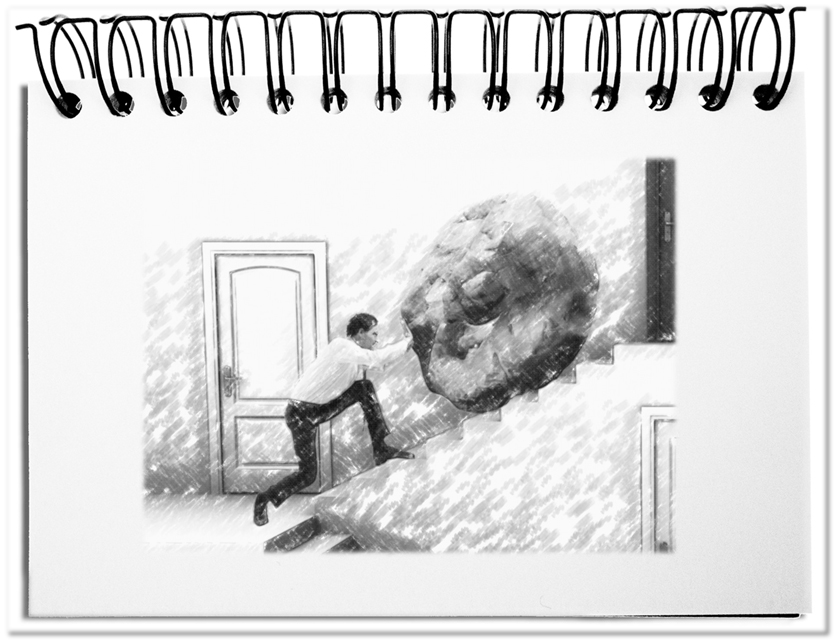In der griechischen Mythologie hat Sisyphos die Götter ausgetrickst und den Zugang zum Hades verschlossen, indem er den Todesgott Thanatos fesselte. Nach dessen Befreiung und weiteren frevlerischen Taten wurde er schließlich von Hermes dazu verurteilt, einen Felsblock auf einen Berg hinaufzurollen. Kurz bevor er den Gipfel erreicht, rollt der Felsblock jedoch immer wieder zurück ins Tal – und das für alle Zeiten. Heute spricht man auch von Sisyphosarbeit, wenn man eine schwere Arbeit ohne absehbares Ende durchführen muss. Erst Albert Camus hat der Geschichte eine hoffnungsvolle Sichtweise gegeben – „La lutte elle-même vers les sommets suffit à remplir un cœur d’homme. Il faut imaginer Sisyphe heureux.“1 Wir sind glücklich, da die Aufgabe uns ausfüllt. Der Felsblock des Sisyphos wird heute in vielen kleinen und großen Disruptionen erkennbar – jede neue Version einer Software zerstört die eingeübte Routine; die Kulturtechniken, wie Lesen, Schreiben und Rechnen, werden vom stets verfügbaren Smartphone übernommen; das Internet löst die Geschäftsmodelle der vierten Gewalt auf. Damit erhält die Metapher durch das disruptive Herunterrollen des Felsens eine weitere Bedeutung.
In der Vergangenheit hat man den vorliegenden Sachverhalt nach dem spätlateinischen Wort für Zurückwälzen und Zurückdrehen benannt – Revolution. Das Wort Disruption verschiebt die Aufmerksamkeit auf das, was schließlich zu dem tief greifenden Wandel führt, auf die zerstörerische Veränderung. Den Betroffenen fällt das Loslassen des Alten und das sich Einlassen auf das Neue schwer, weil sie sich in ihrer Routine nach der letzten Unterbrechung endlich zurechtfinden.
- Anstrengung
Die Verunsicherung, die die Zielgruppe erleidet, ergibt sich aus der Notwendigkeit, die bisherigen Grundannahmen infrage stellen zu müssen. Zu Beginn fehlen die Bezugspunkte, die dazu genutzt werden, um die neuen Vorgehen einzuüben. Da sich derartiger Wandel in unterschiedlichen Bereichen wiederholt, sind wir der damit einhergehenden Unsicherheit regelmäßig ausgeliefert – und der Tatsache, dass man zu Beginn häufig nicht zweckmäßig reagiert. Diese Anstrengung vor Augen zu haben erzeugt instinktiven Widerstand bei den Betroffenen und belastet die Umsetzung. Und das, obwohl wir im Laufe des Lebens fast alle Disruptionen glücklich überwinden. - Leistung
Es reicht jedoch nicht, das Neue anzunehmen. Wir wollen auch überdurchschnittliche Leistung liefern. Desto weiter wir uns von der Talsohle bergauf bewegen, desto routinierter beherrschen wir die Last. Manche schaffen es, mit sich selbst in Wettbewerb zu gehen und sich stetig zu übertrumpfen. Die derart gewonnene Praxis wird absehbar durch die nächste Disruption infrage gestellt. Die Halbwertszeit von Schulwissen ist zwanzig Jahre, Hochschulwissen halbiert sich bereits nach 10 Jahren, Technologiewissen nach vier Jahren und IT Wissen schon nach zwei Jahren – der IT-Spezialist hebt sich ohne unentwegtes Lernen nach 10 Jahren nicht mehr vom Laien ab. Dieser Verfall wird durch die vielen kleinen Disruptionen bewirkt, die wir nicht bewusst bemerken. Und das, obwohl jeder von uns seinen zerstörenden Beitrag liefert, indem wir Verbesserungen hier und Erneuerungen da erzeugen. - Den Gipfel vor Augen
Ich erinnere mich nicht, ob Sisyphos den Gipfel vor Augen hat und ob er sich an den immer gleichen Weg erinnert. Vermutlich liegt seine ganze Konzentration auf dem Bewegen der übermenschlichen Last. Das würde den Wachstumsfanatikern entsprechen, die glauben, dass ein Berg keinen Gipfel hat – was zu dem Trugschluss führt, dass der Felsen nicht zurückrollen kann, da er sich ja nie seinem Klimax wirklich nähert, der im Unendlichen liegt. Sobald Viabilität als Lebenszweck erkannt wird, nähert man sich dem Blickwinkel von Camus und betrachtet das Zurückrollen als einen Fortschritt auf dem Weg, der unseren unendlichen Einsatz erfordert. Obwohl wir im Alltag immer ein Ziel vor Augen haben, das erreicht werden soll, der Gipfel, wird durch den Mythos der Weg zum Ziel. - Das Herunterrollen
Dass der Fels herunterrollt, entspricht unserer Erfahrungswelt. Eigentlich wissen wir, dass kein Berg unendlich hoch ist. Um die Aufgabe des unendlichen Hinaufrollens nachvollziehbar zu machen, braucht es die Störung, die den Fels wieder ins Tal befördert. Neben dem unendlichen Weg löst das Zurückrollen zusätzlich eine mitfühlbare Frustration aus. Nach all der Anstrengung und Übung, den Gipfel vor Augen entgleitet der Fels unserer Gewalt und macht den scheinbaren Fortschritt zunichte. Betrachten wir die erneute Verlängerung des Weges allerdings nicht als Rückschritt, sondern als eine große Hürde auf dem Weg nach oben, dann stellt diese Störung nur unsere Aufgabe sicher. Der Weg bleibt gleich unendlich. Nichtsdestotrotz bietet dieser Moment ja auch eine Verschnaufpause. - Für immer
Das Besondere von solchen Kreisläufen ist die Tatsache, dass es keinen Anfang und kein Ende gibt. So wie sich das Jahr ohne Unterlass dreht, der Tag, der die Nacht ablöst und so fort, so schleppt sich Sisyphos den Hang hinauf. Die Gewissheit des erneuten Herunterrollens liefert seine Bestimmung, die er mit all seiner Kraft erfüllen muss. Auch im Umgang mit heutigen Disruptionen können wir nicht anders, als uns auf das Neue einzulassen und uns anzustrengen – vom ersten Moment an und wohl wissend, dass die nächste Disruption bereits auf dem Weg ist. Das Ende ist nicht absehbar.
Fazit: Was würde Sisyphos machen, wenn der Fels oben stabil liegen bliebe? Wäre das nicht schlimmer? Er hat die Kraft, um die erforderliche Anstrengung zu bewältigen. Wir wissen, dass er die erforderliche Leistung erbringen kann. Und offensichtlich erträgt er auch den Frust kurz vor dem Gipfel, wenn der Fels sich wieder von ihm löst und hinunterrollt – für immer.
Der wichtigste Auslöser für Disruptionen ist der technologische Fortschritt, der bereits so schnell unterwegs ist, dass nicht alle seine Neuerungen zur Umsetzung gelangen. Da sich die Entwicklungszeit nicht ganz so schnell beschleunigt, können wir davon ausgehen, dass die nächsten Disruptionen bereits in Vorbereitung sind. Am besten stellen wir uns darauf ein und sehen die Vorteile, anstelle über die Anstrengungen zu lamentieren. Damit wird der Mythos des Sisyphos zur idealen Metapher für Disruptionen.
1)Albert Camus, Der Mythos des Sisyphos
„Der Kampf selbst hin zu den Gipfeln genügt, um das Herz eines Menschen zu füllen. Wir müssen uns Sisyphos glücklich vorstellen.“

